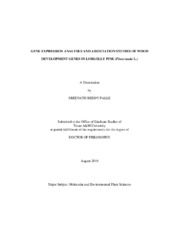| dc.contributor.advisor | Loopstra, Carol | |
| dc.creator | Palle, Sreenath Reddy | |
| dc.date.accessioned | 2011-10-21T22:03:17Z | |
| dc.date.accessioned | 2011-10-22T07:10:39Z | |
| dc.date.available | 2011-10-21T22:03:17Z | |
| dc.date.available | 2011-10-22T07:10:39Z | |
| dc.date.created | 2010-08 | |
| dc.date.issued | 2011-10-21 | |
| dc.date.submitted | August 2010 | |
| dc.identifier.uri | https://hdl.handle.net/1969.1/ETD-TAMU-2010-08-8424 | |
| dc.description.abstract | Gene expression analyses using native populations can provide information on the genetic and molecular mechanisms that determine intraspecific variation and contribute to the understanding of plant development and adaptation in multiple ways. Using quantitative real time – polymerase chain reaction (qRT-PCR), we analyzed the expression of 111 genes with probable roles in wood development in 400 loblolly pine individuals belonging to a population covering much of the natural range. Association mapping techniques are increasingly being used in plants to dissect complex genetic traits and identify genes responsible for the quantitative variation of these traits. We used candidate-gene based association studies to associate single nucleotide polymorphisms (SNPs) in candidate genes with the variation in gene expression. The specific objectives established for this study were to study natural variation in expression of xylem development genes in loblolly pine (Pinus taeda L.) using qRT-PCR, to associate SNPs in candidate genes with the variation in gene expression using candidate-gene based association analyses and to detect loblolly pine promoter polymorphisms and study their effect on gene expression.
Out of the 111 genes analyzed using qRT-PCR, there were significant differences in expression among clones for 106 genes. Candidate-gene based association studies were performed between 3937 single nucleotide polymorphisms (SNPs) and gene expression to associate SNPs in candidate genes with the variation in gene expression. To the best of our knowledge, this is the first association genetic study where expression of a large number of genes, analyzed in a natural population, has been the phenotypic trait of interest. We cloned and sequenced promoters of 19 genes, 16 of which are transcription factors involved in wood development and drought response. SNP discovery was done in 13 of these promoters using a panel of 24 loblolly pine clones (unique genotypes). SNP genotyping is underway in the entire association population and association analyses will be done to study the effects of promoter SNPs on gene expression. The results from this project are promising and once these associations have been tested and proved, we believe that they will help in our understanding of the genetics of complex traits. | en |
| dc.format.mimetype | application/pdf | |
| dc.language.iso | en_US | |
| dc.subject | Gene expression analysis | en |
| dc.subject | Association studies | en |
| dc.subject | Wood development | en |
| dc.subject | Loblolly pine | en |
| dc.subject | Promoter polymorphisms | en |
| dc.title | Gene Expression Analyses and Association Studies of Wood Development Genes in Loblolly Pine (Pinus taeda L.) | en |
| dc.type | Thesis | en |
| thesis.degree.department | Ecosystem Science and Management | en |
| thesis.degree.discipline | Molecular and Environmental Plant Sciences | en |
| thesis.degree.grantor | Texas A&M University | en |
| thesis.degree.name | Doctor of Philosophy | en |
| thesis.degree.level | Doctoral | en |
| dc.contributor.committeeMember | Pepper, Alan | |
| dc.contributor.committeeMember | Krutovsky, Konstantin | |
| dc.contributor.committeeMember | Byram, Thomas | |
| dc.type.genre | thesis | en |
| dc.type.material | text | en |


